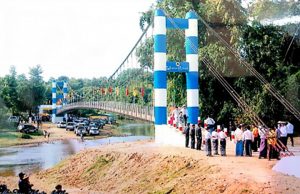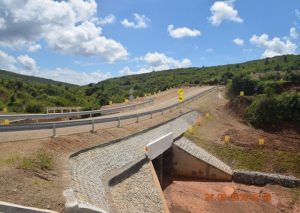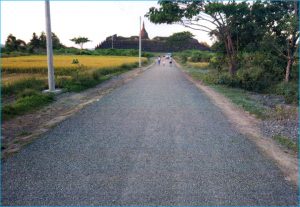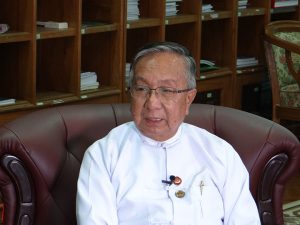2 April
Union Construction Minister U Han Zaw
The Ministry of Construction works tirelessly to build roads and bridges and develop the housing sector across the entire country.
We’ve interviewed the Union Minister for Construction, U Han Zaw, and the Deputy Minister U Kyaw Lin on what their ministry has accomplished so far in the third year of their term.
U Han Zaw, Union Minister for Construction
Q: Could you provide a brief explanation of your ministry’s policies, objectives, responsibilities, strategies and tactics to us?
A: Our policy is to develop our roads, bridges and residential buildings and implement uniform development on the sub-national level in that regard. We aim to reduce the cost and time for transportation and ensure every citizen has the opportunity to stay in dwellings that meet good living standards. Every road and bridge must be upgraded and made sustainable for a long time, and there must be socioeconomic development for the rural residents as well. To highlight some of the ministry’s objectives, we aim to upgrade over 42,000 km of roads to ASEAN Class III and expand to at least 18 feet tar/concrete roads by 2030. We will ensure all bridges are 24 feet wide, two lane driveways, and are upgraded to either RC steel reinforced concrete bridges, PC concrete bridges, or steel bridges. Furthermore, we will transform all 330 townships in Myanmar into organized settlements with modern urban planning by 2030 as well. Lastly, we aim to install all-weather roads in 80 per cent of rural villages.

Q: Could you go into detail about upgrading the rural roads?
A: There’s approximately 55,500 miles of rural roads in Myanmar. By 2030, we’re looking to upgrade different sectors of them categorized into classes A, B, and C. There are 25,600 miles of roads grouped in Class A that will be expanded to 12 feet wide and upgraded to tar or concrete roads. Class B roads have 17,300 miles that will also be expanded to 12 feet in width and upgraded to tar, concrete, or gravel roads. Class C has 12,500 miles of roads will likewise be expanded to 12 feet in width and upgraded to gravel or basic solid roads. Our strategies are implemented based on the national budget. We carry out projects with high likelihoods via the public-private partnership program. We also receive grants and loans from international development partners, such as JICA, ADB, WB, KOICA and TICA, and other donors.
The Ministry of Construction, UN-Habitat, and Myanmar Engineering Society are implementing Myanmar National Building Code – 2016, with the ministry in the lead. We’ve also compiled an English version. The Union-Attorney General’s office notified us that we need to provide the building code in Myanmar in order to receive approval from the Union Government for publishing. So, we’re currently doing that too.
Q: We’d like to know about the Construction Industry Development Board Bill.
A: We are undergoing discussions with the Union Attorney-General’s office and the Ministry of Planning and Finance concerning that bill. We managed to pass The Condominium Law on 29 January 2016, its related bylaw on 7 December 2017, and additional amendments were enacted on 4 December 2018.
Q: Are there any other bills being drafted?
A: We are currently drafting the Underground Water Administration Bill, the Urban Planning and Regional Development Project Bill, and the National Housing Development Bill.
We have four main projects in our portfolio. They are the New Mandalay Resort City in PyinOoLwin Township, Mandalay Region, the Eco Green City project and Korea-Myanmar Industrial Complex project in Hlegu Township, Yangon Region, and the Smart District project in Dagon Seikkan Township also in Yangon Region.
Q: What other tasks do you have planned for the future?
A: The Ministry of Construction is organizing an administrative group that will allow us to step back and permit work to progress with the necessary technology and skills, while being free from corruption at the same time.

U Kyaw Lin, Deputy Minister for Construction
Q: What has the Ministry of Construction accomplished in its third year?
A: The Department of Building assumes the responsibility of reviewing and negotiating construction projects. The Construction Review Committee has reviewed and approved 2,991 construction projects for Union-level organizations and the 25 Union ministries.
The Construction Industry Development Board Law is still in the bill stage but we are pushing to have it enacted. The Department of Building has constructed 90 assemble board houses for returnees in Rakhine State and construction is ongoing for 43 board houses in four other villages.
Q: Please elaborate further.
A: We’ve built 384 high court buildings, hospitals, college and university buildings submitted by Union-level organizations and Union Ministries with 319 projects ongoing. We are trying to get ISO/IEC 17025 certificate for Myanmar Inspection & Testing Services Ltd (Lower Myanmar). The Department of Building has published a Field Engineer’s Manual and Third Party Inspector’s Manual. They are currently collaborating with South Korea to publish the Myanmar Standards For Materials.
Q: What have the departments for roads and bridges accomplished?
A: They have worked along the Myitkyina-Sumprabum-Putao road in Kachin State, paving concrete or tar roads, digging canals, and building embankments where necessary. We have opened the Tiyanzup Bridge and Drukha Bridge along that road as well.
Q: Can you tell us their completed tasks on the sub-national level?
A: We upgraded roads in Kayah State with some of the loans from JICA and constructed the 200 feet-long Dawnoku Bridge in Loikaw. We are working with BOT company for upgrading roads in Kayin State and the rest of the loans will be supplemented from Asian Development Bank. In Chin State we started construction of the Kaladan Bridge (Paletwa) in the 2017-2018 FY and aim to complete construction this 2019-2020 FY. Similarly, we’ve upgraded roads in Mon State with the allotted Union budget and JICA loans and have started construction on the Attayan (Sabel Gu) Bridge on the Kyaikmaraw-Sabel Gu-Kawtpanaw road. In Rakhine State, we are also upgrading the roads including paving 8 miles of concrete roads along the Ponnagyun-Yathedaung-Buthidaung road.
We will also upgrade the Ngataingchaung-Gwa-Thandwe road with loans from the World Bank. We have completed two bridges on Yangon-Sittway road, one on Myebon-Minpya road and one in Sittway while two bridges are still in process. JICA loans are also used to upgrade roads in Shan State and we have started construction of the Takaw Bridge and Thanlyin Bridge (Tarsan) over the Thanlyin River.

Q: How has the ministry addressed the housing requirements?
A: The Department of Urban and Housing Development has completed 6 townships in the annual shortlist from April 2018 to February 2019.
The Korea-Myanmar Industrial Complex (KMIC) is in the construction phase on 558 acres of Nyaung Napin training school in Hlegu Township. The ‘Housing Finance Development Project, MY24’ from JICA’s ODA Two-Step Loan aims to provide people with low income a chance to own low-cost housings at low interest rates.
Q: Could you speak a little bit more about low-cost housing?
A: Our Ministry is looking to put up for sale the 4,452 rooms from low-cost buildings completed in Yangon Region during the 2018-2019 FY. We also started the housing saving system on 1 August 2016. We managed to provide Housing Mortgage Loans for people to own houses.
As of 31 January 2019, there are 25,000 people using the housing saving system with a collective K23 billion in savings. K35.17 billion have been provided to 2,720 people for purchasing homes. Lastly, the CHID Bank is increasing its objectives and aspirations to develop basic infrastructure.
By Hanny Win, Naing Lin Kyi
Translated by Pen Dali



